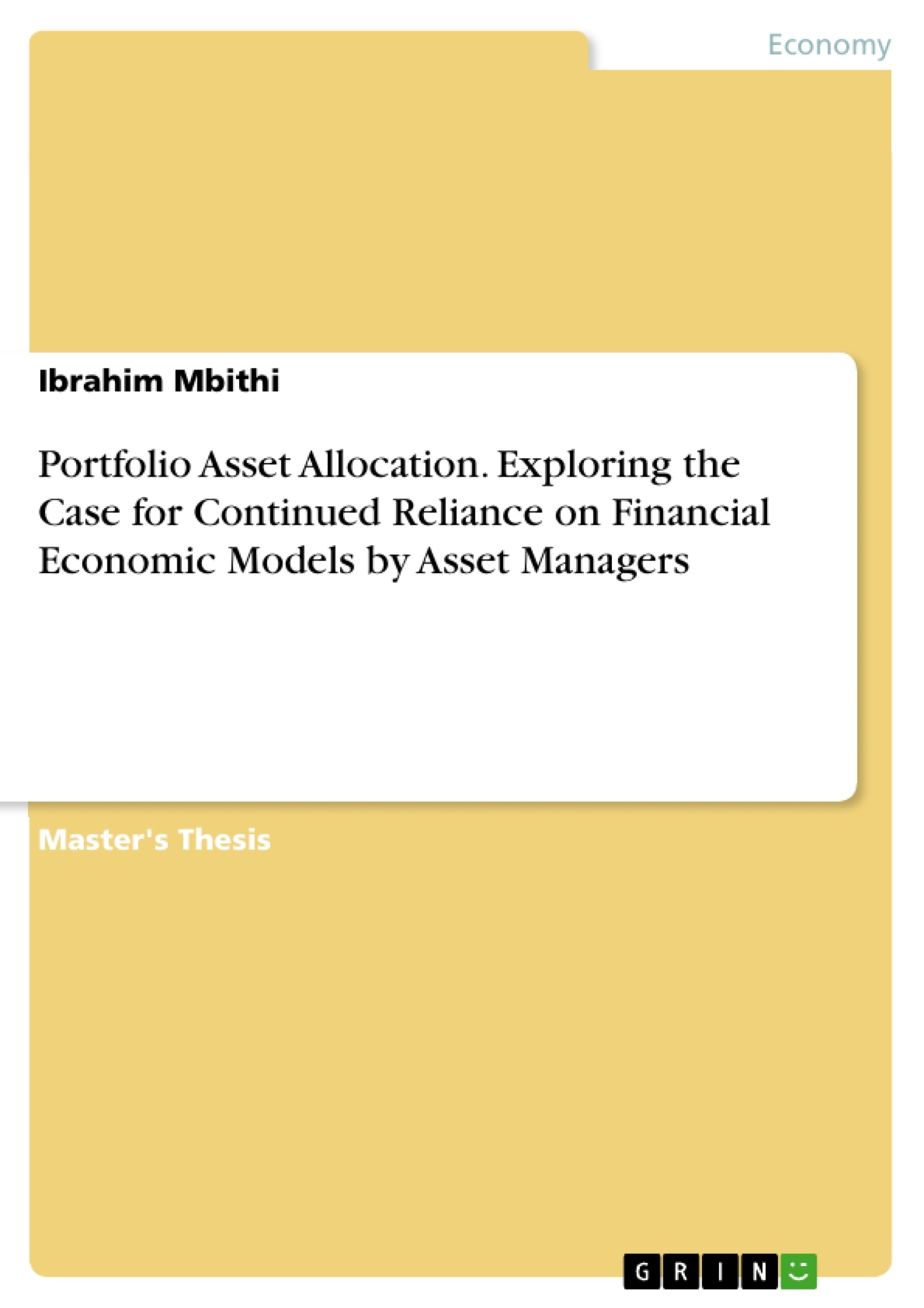In this paper, I address the theme of asset allocation in a pension fund portfolio using passive index funds and exchange-traded funds (ETFs). To illustrate this, I have created
five model portfolios according to CAPM (Capital Asset Pricing Model) and MPT (Modern Portfolio Theory) models. My results are interesting because one of the five
portfolios comes on top of the rest as a suitable portfolio for the pension fund. Since many investors are not experts, they usually leave the responsibility of managing their
asset portfolios to asset managers. And in order to attract as many investors as possible to their boutiques, asset managers will harp on about their superior portfolio returns that
beat the market. To beat the market they incur transaction costs which lower returns for investors. Most investors have come to acknowledge that capital markets are efficient
thus the idea about beating them is a false proposition. In the face of this reality, asset managers and investors have turned to passive investment strategies. I conclude that
superior asset allocation and passive index investing through exchange-traded funds form a unique set of tools for pension fund investment managers.
Inhaltsverzeichnis (Table of Contents)
- Introduction
- Problem Statement
- Pension Funds - Background
- Research Objectives
- Literature Review
- Overview Etfs Industry
- Research Design
- Vanguard Group Inc.
- Portfolio Building
- Step 1 (Age)
- Step 1 (Asset Class)
- Application Of Financial Economic Models
- MPT
- CAPM
- Results
- Priority Ranking Matrix
- Pension Fund Portfolio
- Interpretation And Analysis
- Challenges & Critique
- Future Perspective
- Conclusion
Zielsetzung und Themenschwerpunkte (Objectives and Key Themes)
This thesis aims to explore the use of passive index funds and exchange-traded funds (ETFs) in constructing a pension fund portfolio, demonstrating how this approach can be implemented effectively. The author analyzes the application of financial economic models like CAPM and MPT to achieve optimal asset allocation. The work's key themes include:- Optimizing pension fund portfolios through passive index funds and ETFs.
- Analyzing the efficiency of capital markets and the role of active vs. passive strategies.
- Applying financial economic models like CAPM and MPT to asset allocation.
- Evaluating the effectiveness of different portfolio models for pension fund investment.
- Exploring the future of passive investing and its implications for pension funds.
Zusammenfassung der Kapitel (Chapter Summaries)
- Introduction: This chapter introduces the topic of asset allocation in pension fund portfolios using passive index funds and ETFs. It outlines the need for effective strategies to manage pension fund investments in light of efficient capital markets and the limitations of active investment approaches.
- Problem Statement: The chapter defines the central problem addressed in the thesis: How can pension fund managers optimize their portfolios through effective asset allocation using passive index funds and ETFs, while navigating the complexities of efficient capital markets and the limitations of active management?
- Pension Funds - Background: This chapter provides a foundational understanding of pension funds, exploring their structure, purpose, and the challenges they face in managing investments effectively in today's financial landscape.
- Research Objectives: This chapter outlines the specific research goals of the thesis, highlighting the key questions that the author seeks to answer through their analysis.
- Literature Review: The chapter provides a comprehensive overview of existing literature on passive index funds, ETFs, asset allocation strategies, and relevant financial economic models. This section lays the theoretical groundwork for the research by summarizing key concepts and findings from previous studies.
- Overview Etfs Industry: This chapter delves into the ETF industry, exploring its structure, evolution, and role in modern investment strategies. It sheds light on the unique characteristics and benefits of ETFs, providing a context for their application in pension fund portfolios.
- Research Design: The chapter outlines the research methodology employed by the author. This section details the research design, data collection methods, and the specific approach taken to address the research objectives.
- Portfolio Building: This chapter explores the process of constructing a well-balanced portfolio for pension fund investments, considering factors such as age, asset class, and risk tolerance. It presents a structured approach to portfolio construction based on industry best practices.
- Application Of Financial Economic Models: This chapter delves into the practical application of financial economic models like MPT and CAPM in the context of asset allocation. It demonstrates how these models can be used to identify optimal asset mixes for different investment objectives.
- Results: This chapter presents the results of the author's research, showcasing the performance of different portfolio models and the key findings related to the effectiveness of passive index funds and ETFs in pension fund portfolios.
- Interpretation And Analysis: This chapter provides an in-depth analysis of the research results, offering interpretations of the findings and discussing their implications for pension fund managers. It also explores the challenges and limitations of the research methodology and outlines potential avenues for further research.
Schlüsselwörter (Keywords)
The primary focus of this work lies in the realm of asset allocation within pension funds. The author emphasizes the use of passive index funds and exchange-traded funds (ETFs) as key tools for optimizing portfolio performance. Central to this exploration are the theoretical frameworks of the Capital Asset Pricing Model (CAPM) and Modern Portfolio Theory (MPT), which provide the foundation for effective asset allocation decisions. This research also examines the efficiency of capital markets, highlighting the advantages of passive strategies over active management techniques.- Citar trabajo
- Ibrahim Mbithi (Autor), 2009, Portfolio Asset Allocation. Exploring the Case for Continued Reliance on Financial Economic Models by Asset Managers, Múnich, GRIN Verlag, https://www.grin.com/document/282441



